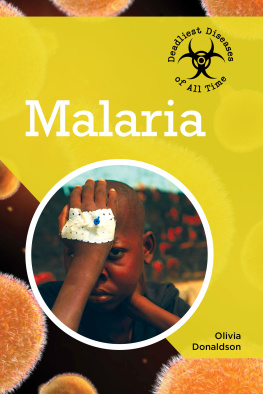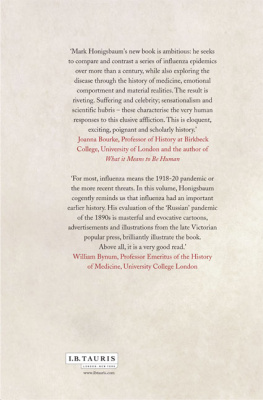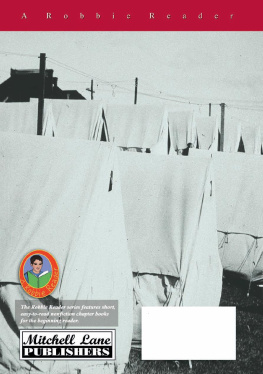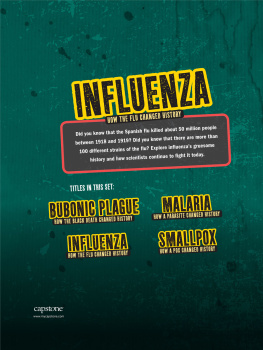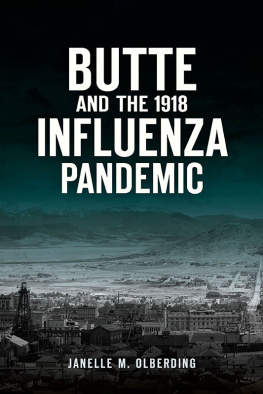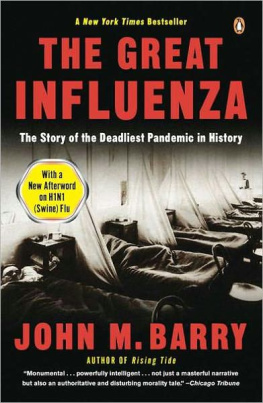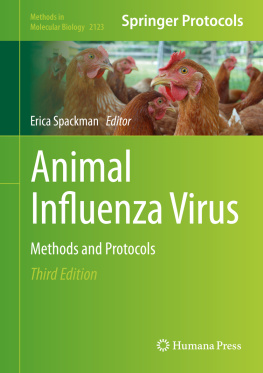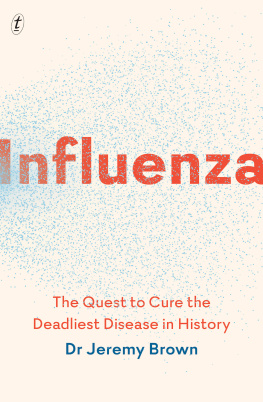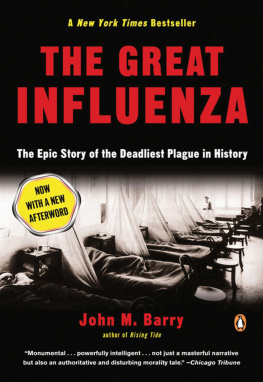Olivia Donaldson - Influenza
Here you can read online Olivia Donaldson - Influenza full text of the book (entire story) in english for free. Download pdf and epub, get meaning, cover and reviews about this ebook. year: 2015, publisher: Cavendish Square Publishing, genre: Science. Description of the work, (preface) as well as reviews are available. Best literature library LitArk.com created for fans of good reading and offers a wide selection of genres:
Romance novel
Science fiction
Adventure
Detective
Science
History
Home and family
Prose
Art
Politics
Computer
Non-fiction
Religion
Business
Children
Humor
Choose a favorite category and find really read worthwhile books. Enjoy immersion in the world of imagination, feel the emotions of the characters or learn something new for yourself, make an fascinating discovery.
- Book:Influenza
- Author:
- Publisher:Cavendish Square Publishing
- Genre:
- Year:2015
- Rating:5 / 5
- Favourites:Add to favourites
- Your mark:
- 100
- 1
- 2
- 3
- 4
- 5
Influenza: summary, description and annotation
We offer to read an annotation, description, summary or preface (depends on what the author of the book "Influenza" wrote himself). If you haven't found the necessary information about the book — write in the comments, we will try to find it.
Influenza — read online for free the complete book (whole text) full work
Below is the text of the book, divided by pages. System saving the place of the last page read, allows you to conveniently read the book "Influenza" online for free, without having to search again every time where you left off. Put a bookmark, and you can go to the page where you finished reading at any time.
Font size:
Interval:
Bookmark:


Published in 2015 by Cavendish Square Publishing, LLC
243 5th Avenue, Suite 136, New York, NY 10016
Copyright 2015 by Cavendish Square Publishing, LLC
First Edition
No part of this publication may be reproduced, stored in a retrieval system, or transmitted in any form or by any meanselectronic, mechanical, photocopying, recording, or otherwisewithout the prior permission of the copyright owner. Request for permission should be addressed to Permissions, Cavendish Square Publishing, 243 5th Avenue, Suite 136, New York, NY 10016. Tel (877) 980-4450; fax (877) 980-4454.
Website: cavendishsq.com
This publication represents the opinions and views of the author based on his or her personal experience, knowledge, and research. The information in this book serves as a general guide only. The author and publisher have used their best efforts in preparing this book and disclaim liability rising directly or indirectly from the use and application of this book.
CPSIA Compliance Information: Batch #WW15CSQ
All websites were available and accurate when this book was sent to press.
Library of Congress Cataloging-in-Publication Data
Donaldson, Olivia, author.
Influenza / Olivia Donaldson.
pages cm. (Deadliest diseases of all time)
Includes bibliographical references and index.
ISBN 978-1-50260-092-9 (hardcover) ISBN 978-1-50260-093-6 (ebook)
1. InfluenzaHistoryJuvenile literature. 2. InfluenzaVaccinationHistoryJuvenile literature. I. Title.
RC150.D66 2015
614.518dc23
2014028912
Editor: Kristen Susienka
Senior Copy Editor: Wendy A. Reynolds
Art Director: Jeffrey Talbot
Senior Designer: Amy Greenan
Senior Production Manager: Jennifer Ryder-Talbot
Production Editor: David McNamara
Photo Researcher: J8 Media
The photographs in this book are used by permission and through the courtesy of: Cover photo and page 1, SAM PANTHAKY/AFP/Getty Images; Cover photo and page 1, BSIP/Universal Images Group/Getty Images; iStock.com/ RobertCrum, 4; Otis Historical Archives National Museum of Health & Medicine/File:Emergency hospital during Influenza epidemic, Camp Funston, Kansas - NCP 1603.jpg/Wikimedia Commons, 8; Mondadori/Getty Images, 10; National Photo Company/File:1918 flu outbreak.jpg/Wikimedia Commons, 15; Everett Collection, 20; Hulton Royals Collection/Getty Images, 22; Stock Montage/Archive Photos/Getty Images, 25; Interfoto/Sammlung Rauch/Mary Evans Picture Library, 28; Roger Harris/Science Photo Library/Getty Images, 30; Plik:Richard Pfeiffer.jpg/Wikimedia Commons, 33; Sebastian Kaulitzki/Shutterstock.com, 39; Keystone/Hulton Archive/Getty Images, 40; Hulton Archive/File:Louis Pasteur portrait photo.jpg/Wikimedia Commons, 44; kkgas/iStock/Thinkstock, 46; Justin Sullivan/Getty Images, 49; Anadolu Agency/Getty Images, 50; Karen Kasmauski/Science Faction/Getty Images, 53; NIAID/File:HIV-infected T cell (6813384933).jpg/Wikimedia Commons, 54; John Moore/Getty Images, 57.
Printed in the United States of America



T here have been many diseases that have plagued humanity throughout time. One of the most deadly, and one still without a definite cure, is influenza. As recently as April 2009, a new strain of the flu was identified in Mexico that proved to be deadly for some of its younger victims. Named H1N1, it was also called swine flu because of its similarity to a strain of influenza from which pigs often suffer. This new flu strain would not stay limited to Mexico, however. It soon spread to the United States, Europe, and the rest of the world. By June 2009, it was so widespread that the World Health Organization (WHO) labeled it as a pandemicthe first influenza pandemic in more than a decade.
In the first twelve months of the H1N1 outbreak, the Centers for Disease Control and Prevention (CDC) estimated that more than sixty million people contracted the disease, with almost 275,000 being hospitalized and over 12,000 dying in the United States alone. One difficulty in dealing with H1N1 in 2009 was the shortage of an effective vaccine. Work began in earnest on one, and by the early fall one was available. However, the supply was limited, so those most susceptible to the fluthe very young and the very oldwere given priority. By November 2009, the number of vaccine doses had increased to more than 61 million, and eventually 80 million were vaccinated against H1N1. The effectiveness of the vaccine led to the WHO stating that the global H1N1 pandemic was over in August 2010. Thats not to say the disease has been eradicatedpeople still get swine flu each year, but the rate of infection has markedly decreased.
Just as outbreaks of influenza are not a new development, pandemics have also occurred over time. In fact, there have been four significant pandemics of the disease in the last 100 years. The firstand deadliestoccurred in 1918, and was inexorably linked to World War I. U.S. soldiers looking to help end the war in Europe instead helped spread a deadly strain of Spanish flu, one that would take more lives than the war itself. This deadly strain of influenza would not stay on the battlefields of Europe, either. The disease made its way back to major American cities, and killed more than 675,000 Americans. Many victims were between the ages of twenty and fifty. This made that particular strain of influenza so unusual, as flu tends to be deadly mostly for infants and the elderly. Not every death can be attributed directly to the flu itself, however. Many patients developed secondary problems such as pneumonia that can prove to be just as deadly.
Two additional flu pandemics hit the world in the late 1950s and late 1960s, but neither was as widespread or deadly as the Spanish flu epidemic of 1918. Some of this can be attributed to improved health care and better treatment for secondary ailments. The world not being embroiled in a global conflict was probably also a contributing factor.
To date, the most recent pandemic occurred in 2009. However, some researchers continue to warn that another global deadly pandemic is not only probable but also likely to happen. It would only take a current strain of influenza mutating, or being developed by other means, to bring about another widespread outbreak similar to the one in 1918.
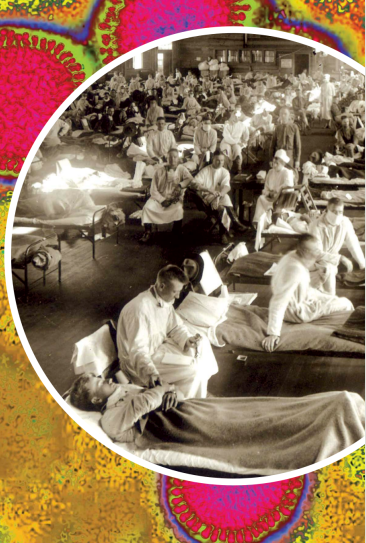

A fter becoming involved in World War I in April 1917, the United States was asked in early 1918 by its allies to increase the number of soldiers it was sending to the European front lines. Germany was pushing back the French and English, and more troops were needed to save the war effort. American soldiers preparing for deployment at Camp Funston in Kansas were succumbing to a powerful strain of influenza. The disease led to some soldiers also getting pneumonia, and almost fifty died.
Font size:
Interval:
Bookmark:
Similar books «Influenza»
Look at similar books to Influenza. We have selected literature similar in name and meaning in the hope of providing readers with more options to find new, interesting, not yet read works.
Discussion, reviews of the book Influenza and just readers' own opinions. Leave your comments, write what you think about the work, its meaning or the main characters. Specify what exactly you liked and what you didn't like, and why you think so.


